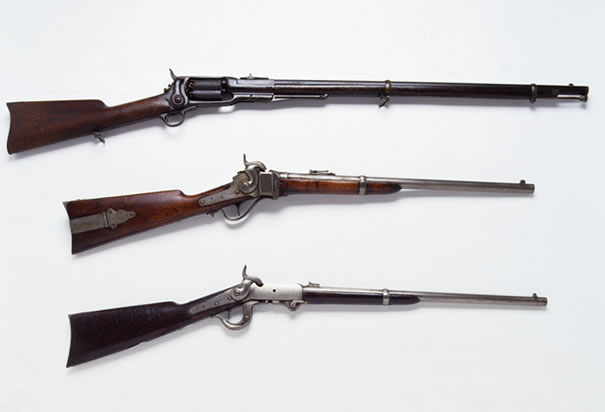The Camera
Cameramen would need "portable darkrooms," a glass plate, and a camera in order to take pictures. They would first pour a mixture of nitrocellulose and ether onto the glass plate. This would create a film on the glass. Then, they would put it in the a bath full of chemicals to make it light sensitive. Then it would go into the camera. After the picture is taken, the plate would be rushed to the darkroom before the film dried. It would be placed in a developer liquid, which would begin to reveal the picture. Then the plate would be washed in a "fixer" to sharpen the image. It would now be on the glass for hundreds of years.
The Henry and Spencer Rifles
The Henry and Spencer rifles were the most effective combat system since the creation of gunpowder. They were the first rifles ever to be able to fire several rounds without reloading. Earlier attempts at repeating rifles had failed miserably. One idea (the rifle at the top) was to incorporate Samuel Colt's revolver mechanism onto a rifle. But the rifle's flawed design resulted in all the rounds leaving the cylinder at once, and flying straight into the sharpshooter's supporting hand.
The Henry and Spencer were very similar in that both rifles had a firing chamber and a chamber below the barrel to hold the rounds, not unlike modern pump-action shotguns. To fire the Spencer, the firer would first half-cock the hammer. Then he would pull the lever to load the next round into the firing chamber. Then he would return the lever, and fully cock the hammer. He is now ready to fire.
To fire the Henry rifle, the firer could pull the lever and fully-cock the gun it one swift motion. In addition to that, the Henry could chamber fifteen rounds as opposed to the Spencer's seven. A perk for the Spencer, was the superior accuracy and muzzle velocity, meaning a better effective range.
The Telegraph and Telephone
Alexander Graham Bell further extended the ability to communicate over long distances with his Telephone design. He discovered that electrical currents could duplicate sound waves exactly, and began working on a way to transmit a voice over telegraph lines. At first, nobody bought the Telephone. Bell had offered to sell his patent to the big Telegraph corporations, but they didn't think it would sell. Bell started his own Telephone company, and soon the profits made him rich. When the corporations offered to buy his patent, he respectfully declined the offers.
The Railroad

No comments:
Post a Comment